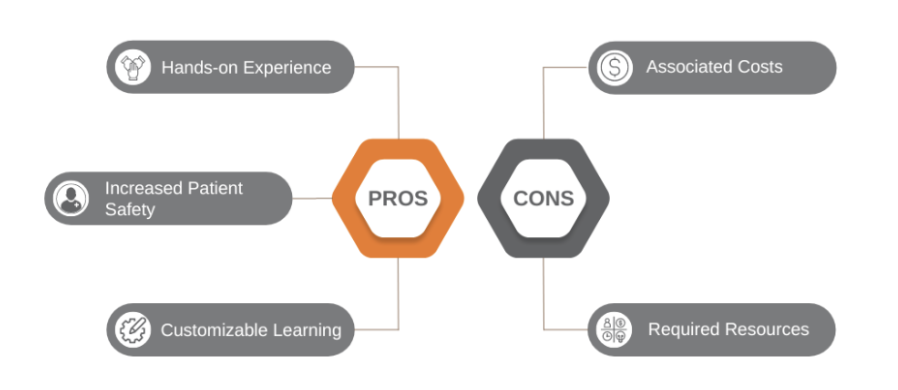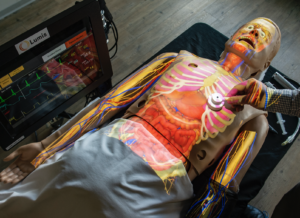
What is Simulation Training?
Simulation-based training in healthcare offers an experience unlike any other to professionals entering clinical practice. In recent years, with rapid technological advances, it is evident that the possibilities for simulation training are endless. Due to this, innovation within simulation technologies has experienced rapid growth. Simulation-based training provides opportunities to practice in an environment that mirrors realistic clinical circumstances. It is often referred to as a bridge between real-world clinical practice and classroom learning.
“Simulation-based learning places students in situations where they can put their classroom knowledge into practice. In healthcare, simulation training has been part of curricula since the 18th century; it has been continually evolving as technology advances.” 1
This type of hands-on training in a low-stakes, low-risk environment provides educators the opportunity to better assess their trainees’ clinical competency before they are unleashed into the workforce. By the same token, a simulated environment affords trainees opportunities to make, and learn from, their mistakes and develop crucial critical thinking skills. Simulation-based training is rapidly becoming the norm for many academic institutions, career, and technical education institutions and hospitals.

Pros of Simulation Training
Research has shown that many students learn better through hands-on experience rather than purely didactic-driven learning. Programs that train healthcare workers typically offer a continuum of training levels that must be completed before someone is deemed fit to work on a live patient. The current modalities of training include a combination of didactic classroom style learning to manikins and task trainers to real-world clinical experience which help round out a students learning experience. Simulation training offers a type of experiential learning that is proven to aid students in retaining information and understanding complex concepts. Studies have shown that active learning also helps improve students’ test scores and accelerate their ability to enter the field.
“Simulation-based education is the pedagogical approach of providing students with the opportunity to practice learned skills in real-life situations.” 2
Practicing procedures and techniques on a manikin, task trainer, and/or other types of simulators help students develop familiarity with patient anatomy and build a mental map of spatial relationships between anatomical structures that are not always easily understandable via textbooks with pictures. This helps them better visualize how underlying systems work with each other, which in turn provides them with the building blocks to make more informed interventional and care decisions.
Another proven benefit of using simulation-based training is the feedback that is provided to trainees while they are practicing. Real-time, actionable feedback not only helps identify areas that students are not fully competent in, but receiving it while they are practicing helps further refine their understanding of fundamental clinical concepts. Aggregated data related to this feedback is a benefit to instructors as well in helping isolate and address the varying learning curves that are invariably present amongst their cohorts. Apart from the hands-on feedback, it is important that simulation platforms allow for customization capabilities. A personalized learning experience tailored towards trainees at different skill levels with different learning styles must be supported. In order to do that, instructors should be able to build these experiences easily based on observed proficiency amongst their student cohorts. A “one size fits most” approach is rarely the best one for any education but specifically for healthcare based training which has the potential to have larger and more immediate negative outcomes both in terms of liability and patient lives.
Because of the associated risks, the most meaningful benefit of simulation training is the freedom that it provides trainees to practice without worrying about potential patient consequences. This lets trainees learn critical, life-saving interventions like intubation that are impossible to master without practice but not feasible to do so on a real patient in a time-sensitive emergency situation.
“It not only allows surgeons to learn without fearing every step they take, but it also saves hospitals and medical schools millions of dollars in damages. Not to mention the countless human lives that are also saved.” 3
Medical errors are the third leading cause of death in the United States. By providing simulation driven training, such errors can be prevented, ultimately making for a better prepared professional and improved patient outcomes.
Cons of Simulation Training
Like most things, simulation-based training also comes with some cons, albeit very few when weighed in balance with the long term benefits. The most significant one is likely the expenses that are incurred by institutions. Initial purchase costs for simulators and task trainers alone can be upwards of $100,000. In addition, running a simulation center requires an investment in infrastructure, resources, staff training, and upkeep. Add to that the cost of updating systems that can become obsolete very quickly, and institutions are looking at high overhead costs. This often deters institutions from implementing simulation training to their programs. This is changing though as new, innovative systems come to market that are more agile and can work with existing simulation equipment and infrastructure.
The InSight Platform®
Lumis’ InSight Platform is an innovative technology platform that aims to enhance the traditional simulation-based training environment. The platform uses hands-free augmented reality, data-driven analytics, and learning content developed by subject matter experts to provide an immersive learning experience across the healthcare spectrum.

The InSight Platform is the only hands-free AR system for medical training. Unlike headset-based VR, which is fully digital, or manikins that are anatomically accurate but static, our approach merges the physical environment with a digital simulation to provide an immersive experience in a realistic clinical setting. The combination of advanced visualizations and the ability to perform tactile manipulations, enhance learning and retention by letting the trainees connect concept with practice. Smart sensor-based peripherals that mimic clinical instruments measure user actions and provide real-feedback letting the trainee see the physiological changes in the anatomy as a consequence of their actions. This enhances comprehension and retention much more than a headset or screen-based VR simulation can. Our cloud-based software, with content developed by subject matter experts, can be accessed by trainees any time and promotes self-learning, reducing trainer and organization burden. Customizable metrics help instructors measure proficiency levels helping them develop personalized learning workflows tailored to varying skill levels. Our solution is easily integrated into training workflows and lets organizations re-use existing infrastructure providing continued return on investment.
Many studies have been conducted analyzing the pros and cons of simulation-based training. The majority of students agree that this type of interactive and immersive learning has improved their abilities to make clinical decisions. Reports have concluded that overall, students feel better prepared to enter the clinical field after having received both hands-on and didactic training.
Our goal as an organization is to democratize healthcare education to reduce the frequency of medical errors and improve longer term patient outcomes. Our modular and completely customizable platform that supports both in-person and online learning and lets organizations scale functionality at the pace of their own growth helps achieve just that.
1 Ologie. “Benefits of Simulation in Education: USAHS.” University of St. Augustine for Health Sciences, 4 Sept. 2021, https://www.usa.edu/blog/simulation-in-education/.
2 Ologie. “Benefits of Simulation in Education: USAHS.” University of St. Augustine for Health Sciences, 4 Sept. 2021, https://www.usa.edu/blog/simulation-in-education/.
3 “Simulation and Training Needs of Organizations.” Hurix Digital, 12 Nov. 2022, https://www.hurix.com/6-reasons-organization-needs-simulation-training/.
